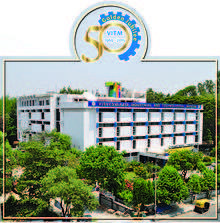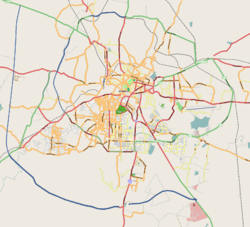Visvesvaraya Industrial and Technological Museum
Coordinates: 12°58′30″N 77°35′47″E / 12.975100°N 77.596400°E
 Visvesvaraya Industrial & Technological Museum | |
 Location in the Map of Bangalore | |
| Established | 14 July 1962 |
|---|---|
| Location |
Kasturba road, Bangalore |
| Coordinates | 12°58′30″N 77°35′47″E / 12.975100°N 77.596400°E |
| Type | Science museum |
| Visitors | 1 million+ |
| Director | K. G. Kumar |
| Curator | K. Madangopal, K. A. Sadhana, Sajoo Bhaskaran, Jyoti Mehra, Shaik Rafi |
| Website | Official website |
The Visvesvaraya Industrial and Technological Museum, (VITM), Bangalore, India, a constituent unit of the National Council of Science Museums (NCSM), Ministry of Culture, Government of India, was established in memory of Bharat Ratna Sir M Visvesvaraya. The building, with a built up area of 4,000 m2 (43,000 sq ft), was constructed in Cubbon Park. It houses various scientific experiments and engines, and was opened by the first Prime Minister of India, Pandit Jawaharlal Nehru, on 14 July 1962. The first gallery set up at VITM, on the theme of 'Electricity', was opened to the public on 27 July 1965.
History
In order to honour Bharat Ratna Sir M Visvesvaraya, the All India Manufacturers’ Organization, Mysore State Board, decided to set up a Science & Technology Museum at Bangalore, and the foundation stone was laid by Shri B. D. Jatti, Chief Minister of Mysore, on 15 September 1958. The Visvesvaraya Industrial Museum Society (VIMS) came to be registered as the nodal agency in order to pool resources from various industrial houses. A building with a display space of 4,000 m2 (43,000 sq ft), which was constructed in Cubbon Park, houses displays of industrial products and engines. it was opened by the first Prime Minister of India, Pandit Jawaharlal Nehru, on 14 July 1962.[1]
However, the society felt that the southern region lacked a science museum. The eastern region already had a science museum in Calcutta under CSIR, which was quite popular, and on the Society’s request CSIR took over VITM. The society nominated a permanent representative to the executive committee of VITM, and on 27 July 1965, VITM opened in Bangalore with the first gallery on the theme of ‘Electricity’.
In the year 1970, VITM launched the Mobile Science Exhibition (MSE) with 24 participatory exhibits mounted on a bus. The MSE Bus travels throughout South India, and it continues to be a very effective tool for science communication in the rural area as the bus carries with it a portable planetarium, telescope for night sky observations, HD large screen TV for science film shows in the evenings, materials for conducting popular science shows and demonstrations aimed towards the general populace.
In 1978, the science museums/centres including VITM were delinked from CSIR and brought under a newly-formed society registered on 4 April 1978 as National Council of Science Museums (NCSM). In 1979, an extension was added to the building, increasing the total area of the museum to 6,900 m2 (74,000 sq ft).
NCSM set up three additional science centers at Gulbarga (Karnataka) in 1984, Tirunelveli (Tamil Nadu) in 1987 and Tirupati (Andhra Pradesh) in 1993, which are functioning under the direct administrative control of VITM. Thus, VITM has become the southern zone headquarters of NCSM.
The museum attracts nearly one million visitors a year, and is open on all days (except Dipawali and Ganesha Chathurthi) from 10:00 to 18:00.
Exhibition galleries
- Engine Hall exhibits engines of various cars, machines used in industry, a jet aircraft engine, and other mechanical devices. The predictability and precision of mechanics is demonstrated by the rolling balls that travel endlessly within metal tracks.
- The How Things Work gallery is an attempt to explain the fundamentals of machines through interactive exhibits. Exhibits include the pulley system, gears, different ways of transferring motion, reducing effort by levers, inclined planes, and screws. Another section deals with the application of these simple machines in daily life.
- The Fun Science gallery that displays exhibits on the science of sound, optics, fluids, math and perception.
- The Electro Technic Gallery contains interactive electrical exhibits which work on the basic principles of electricity, electronics and communication. A renovated version of the Electro Technic gallery was opened to public on 8 April 2010. This gallery exhibits the classical experiments like Oersted's experiment, Barlow's wheel, and Faraday's ring. A demonstration on electrostatics, which includes a Tesla coil and a Van de Graaff generator is on display.
- The Space – Emerging Technology in the Service of Mankind gallery showcases the achievements of the Indian Space Program. It was inaugurated on 19 June 1999.
- The Biotechnological Revolution hall has exhibits on the basics of biotechnology and its applications, including human genome sequencing. It opened on 4 January 2003.
- The BEL Hall of Electronics was inaugurated on 29 June 2004 in collaboration with Bharat Electronics Ltd (BEL). This gallery has exhibits on the basic principles of electronics and information technology.
- The Science for Children gallery, opened on 30 April 2007, houses exhibits that engage children in activities that help them to enjoy science. There is a giant piano over which they can dance to play music. A pin-wall helps the children make impressions of their body parts.
- The Dinosaur Alive exhibit has a moving replica of a Spinosaurus. This pneumatically-operated dinosaur can move its head, hands and tail and roll its eyes at the visitors.
- The Science on a Sphere facility was opened on 28 July 2014, in celebration of the golden jubilee of VITM.
- The Wright Brothers exhibit, also added in 2014, includes a 1:1 scale model of the Wright Brothers’ Flyer, fabricated in-house, and a flight simulator.
In addition to these exhibits, the museum includes a science show hall, a 3D theatre, a 250-seat auditorium, a telemedicine facility, an 11' Celestron telescope with GPS, and a cafeteria.
VITM has developed travelling exhibitions including The World of Astronomical Observatories, The Life and Work of Sir C. V. Raman, Nanotechnology, and The Life and Work of Sir M Visvesvaraya. VITM also hosts, on a regular basis, travelling exhibitions that are developed by other units of NCSM such as Science of Sports, Giants from the Backyard, Chemistry, Disaster - Preparing for the Worst, and Radiations Around Us.
Photo gallery
-
Visvesvaraya Museum entrance
-

Locomotive
-
Steam-powered engine
-
J. J. Thompson room
-
Old Indian aircraft
-
Electricity model
-
Electromagnet model
-
Diesel engine
-
Early aircraft engine
-
Archimedes screw
-
Steam engine
References
- ↑ "Visvesvaraya Industrial and Technological Museum, About page" (Web site). www.vismuseum.gov.in. Retrieved 2012-12-11.
External links
| Wikimedia Commons has media related to Visvesvaraya Industrial and Technological Museum. |